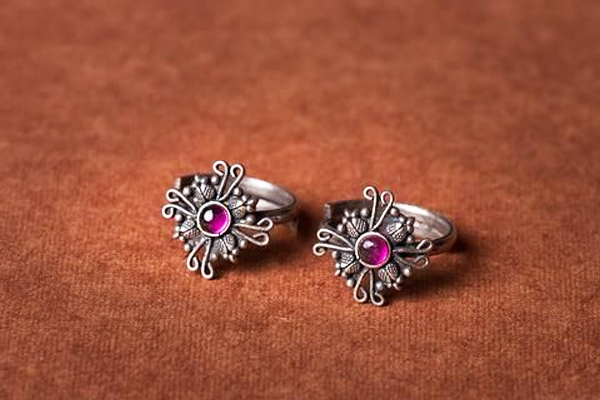
Have you ever noticed the small rings worn on the second toes of many Indian women?
They may appear as simple ornaments, but in Hindu tradition, toe rings, known as bichiya in Hindi, carry deep symbolic and spiritual meaning. They are an important part of solah shringar , the sixteen sacred adornments of a married woman, and are commonly worn after marriage.
But the significance goes far beyond decoration.
Toe rings reflect a union of tradition, health wisdom, and feminine energy. From their placement during Hindu wedding rituals to their link with reproductive wellness in Ayurveda, this humble ornament speaks of a woman’s grace, her marital status, and the subtle flow of life force in her body.
In this blog, you’ll discover the cultural, scriptural, and health-based reasons why women wear toe rings along with how they are evolving in modern fashion.
Cultural and Ritual Significance of Toe Rings
In Hindu tradition, toe rings, known as bichiya in Hindi, metti in Tamil, and mettelu in Telugu are more than ornamental jewellery. They hold deep cultural and ritual significance, symbolizing marital status and the sacred bond between husband and wife.
Symbol of Marital Status
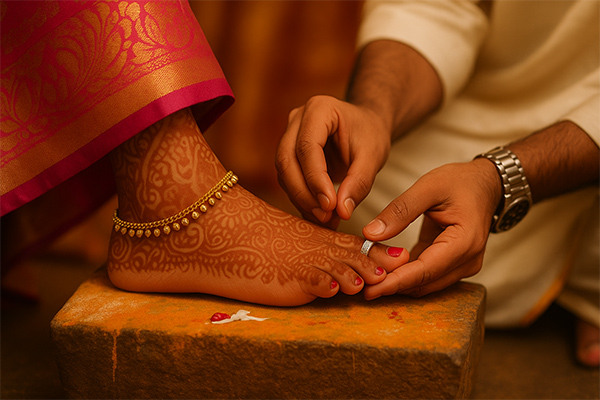
During Hindu wedding ceremonies, the groom places toe rings on the second toe of both the bride's feet. This act signifies the woman's transition into married life and her new role as a wife. The toe rings serve as a visible marker of her marital status, akin to the mangalsutra or wedding ring in other.
Regional Variations and Customs
The practice of wearing toe rings varies across different regions in India:
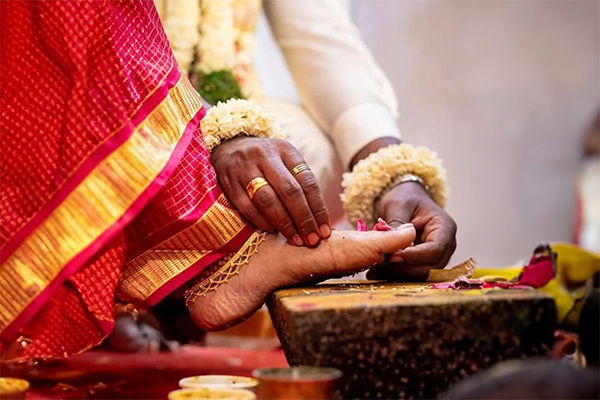
Tamil Nadu: The ritual of placing the bride's foot on a grinding stone (ammi) symbolizes strength and stability in marriage. Following this, the groom adorns her feet with silver toe rings, emphasizing his commitment and respect.
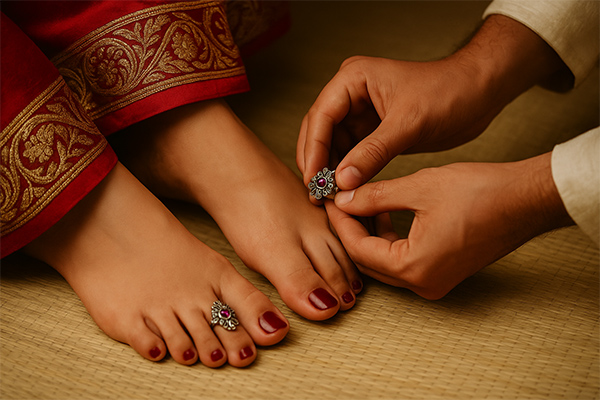
Telugu Traditions: In Telugu weddings, the Sthālīpākaṃ ritual involves the groom adorning the bride's feet with silver mettelu (toe rings), signifying her new status as a married woman.
Scriptural References
While specific mentions of toe rings in ancient scriptures are limited, the Ramayana provides a notable reference. When Sita was abducted by Ravana, she dropped her toe rings to leave a trail for Shri Ram, highlighting their significance even in ancient times.
Symbolism and Beliefs
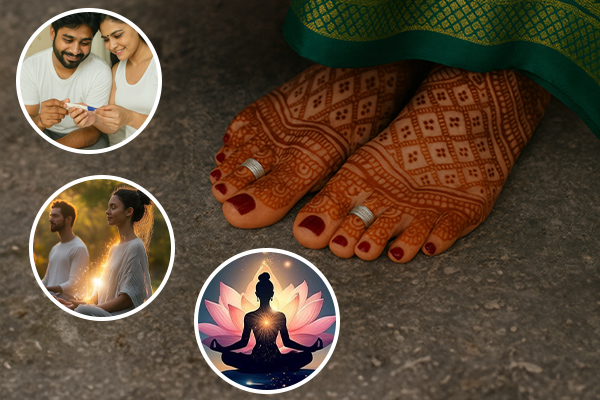
Beyond denoting marital status, toe rings are believed to:
Enhance Fertility: Wearing toe rings is thought to regulate menstrual cycles and promote reproductive health by applying pressure to specific nerves connected to the uterus.
Balance Energy: In Ayurveda, it's believed that toe rings help balance the body's energy flow, maintaining the prana or life force.
Attract Positive Energies: Silver, the preferred metal for toe rings, is considered to have properties that absorb negative energies and enhance well-being.
In summary, toe rings in Hindu culture are not merely decorative but are imbued with profound cultural, spiritual, and health-related significance, reflecting the rich tapestry of traditions and beliefs that have been passed down through generations.
Toe Rings in Scriptures and Ancient Traditions
The tradition of wearing toe rings, or bichiya, is deeply rooted in Hindu culture, with references found in ancient scriptures and epics.
Ramayana: Sita's Toe Ring as a Symbol
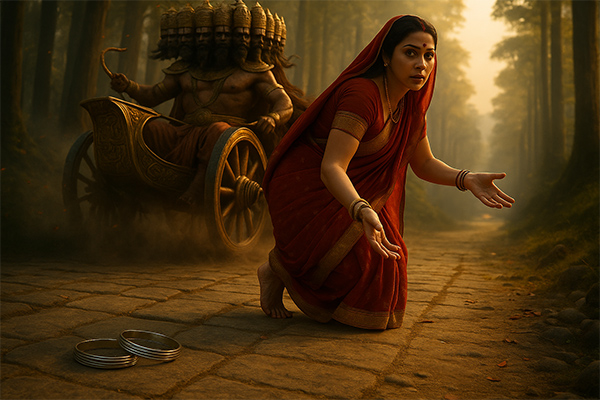
In the epic Ramayana, when Sita was abducted by Ravana, she dropped her toe rings along the path to leave a trail for Shri Ram. This act underscores the significance of toe rings as symbols of marital status and personal identity in ancient times.
Vedic Texts and the Grihya Sutras
The Grihya Sutras, ancient Vedic domestic ritual texts, mention the practice of married women wearing toe rings as a mark of being suhāgin (a blessed married woman). This ritual signifies the woman's marital status and her role in upholding household traditions.
Association with Goddess Lakshmi
According to the Puranas, silver toe rings are associated with Goddess Lakshmi, the deity of wealth and prosperity. Wearing silver toe rings is believed to attract abundance and marital bliss, aligning the wearer with the qualities of the goddess.
Regional Practices and Variations
The tradition of wearing toe rings varies across different regions in India:
Tamil Nadu: Known as metti or kanaiyazhi, toe rings are an integral part of the solah shringar (sixteen adornments) of a married woman.
Telugu Traditions: Referred to as mettelu, toe rings are traditionally worn on the second toe of both feet, symbolizing marital status and invoking blessings for a prosperous married life.
Marathi Culture: Called jodavi, toe rings are often ornate and signify the woman's role as a wife and her commitment to family traditions.
These regional practices highlight the cultural diversity and the shared reverence for toe rings as symbols of marriage and femininity.
Toe Ring Benefits According to Ayurveda and Acupressure
In Hindu tradition, toe rings (bichiya) are not merely ornamental; they are believed to offer various health benefits, particularly concerning women's reproductive health.
Ayurvedic Perspective
According to Ayurveda, the ancient Indian system of medicine, wearing toe rings on the second toe is thought to regulate menstrual cycles and promote reproductive health. This is attributed to the belief that a nerve in the second toe connects to the uterus, and the pressure exerted by the ring stimulates this connection, enhancing uterine health and fertility.
Acupressure and Reflexology
The practice of wearing toe rings aligns with principles of acupressure and reflexology. The second toe is associated with reproductive organs, and applying pressure through a toe ring may stimulate these areas, potentially aiding in alleviating menstrual discomfort and improving reproductive function.
Material Significance: Silver
Silver is the preferred metal for toe rings due to its conductive properties. It is believed to absorb negative energies and promote overall well-being. Additionally, silver is associated with the moon in Vedic astrology, symbolizing calmness and emotional balance, which are beneficial qualities for married women.
In summary, the tradition of wearing toe rings encompasses cultural, spiritual, and health dimensions, reflecting a holistic approach to well-being in Hindu customs.
Different Types of Toe Rings for Women
Toe rings, or bichiya, have evolved over time, blending traditional significance with contemporary fashion. They are available in various designs, materials, and styles, catering to diverse preferences across regions.
Traditional Silver Toe Rings
Silver toe rings are the most common and traditionally worn by married Hindu women. They are usually worn in pairs on the second toe of both feet. Silver is preferred due to its conductive properties, believed to regulate energy flow and provide health benefits.
Ornate and Filigree Designs
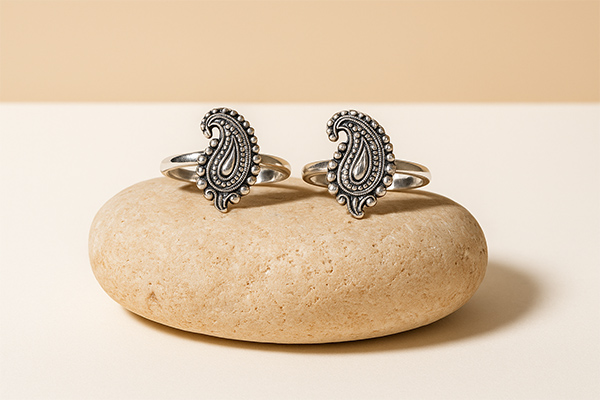
In regions like Odisha, intricate silver filigree work, known as Tarakasi, is used to craft elaborate toe rings. These designs often feature motifs inspired by nature and are considered a symbol of marital status and artistry.
Toe Ring-Anklet Combinations
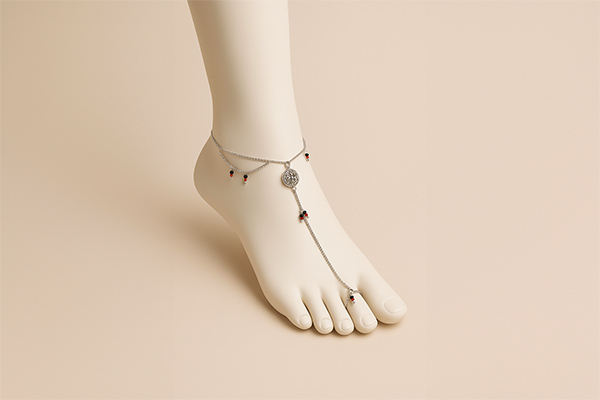
Some designs integrate toe rings with anklets, connected by delicate chains. This style is popular in bridal jewellery, adding elegance and a cohesive look to the feet.
Adjustable and Contemporary Styles
Modern toe rings come in adjustable forms, accommodating various toe sizes. These designs range from simple bands to those adorned with gemstones, catering to both traditional wearers and fashion enthusiasts.
Toe Rings in Contemporary Fashion
Toe rings have made a notable comeback in the fashion industry, with designers incorporating them into their collections. For instance, during the Spring/Summer 2024 runway shows, designers like Paco Rabanne and Miu Miu featured toe rings as part of their ensembles, highlighting their resurgence as a trendy accessory.
This revival has been mirrored in the popularity of toe-ring sandals, a style that combines the elegance of jewellery with the functionality of footwear. Publications like Town & Country have noted the rise of embellished toe-loop sandals as a significant trend for summer 2024, emphasizing their minimalist design and versatility.
Styling Toe Rings Today
Modern toe rings come in various designs, from simple bands to intricate patterns adorned with gemstones. They are often crafted from materials like sterling silver, gold, or even non-precious metals, catering to diverse fashion preferences.
When incorporating toe rings into your wardrobe:
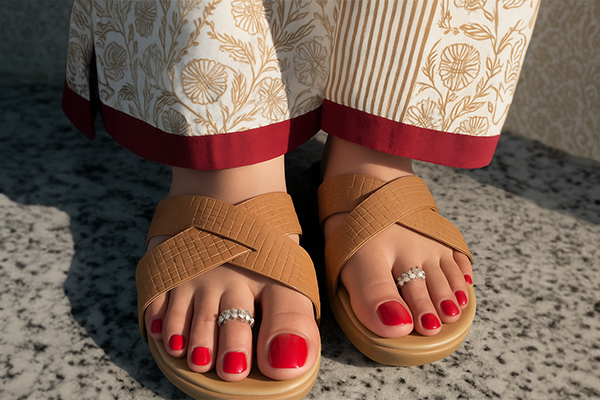
Pair with Open-Toed Footwear: Toe rings complement sandals, flip-flops, and barefoot looks, making them ideal for beach outings or summer events.
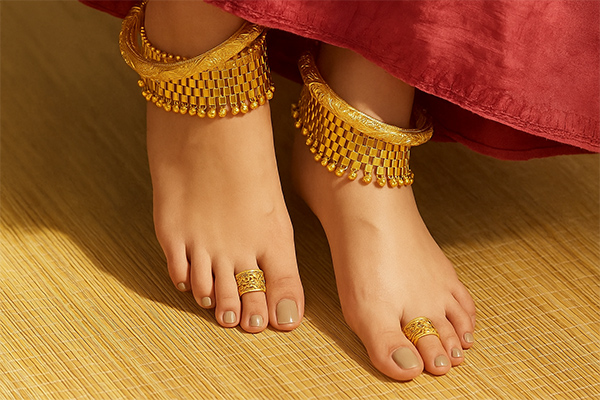
Coordinate with Other Jewellery: Match your toe ring with anklets or bracelets for a cohesive look.
Layering: Wearing multiple toe rings on different toes or stacking them can create a bold fashion statement.
Whether honouring cultural traditions or embracing contemporary trends, toe rings offer a unique way to express personal style and elegance.


-in-Astrology.jpg)
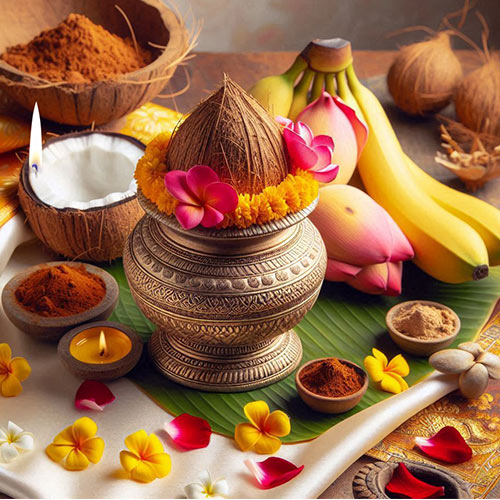


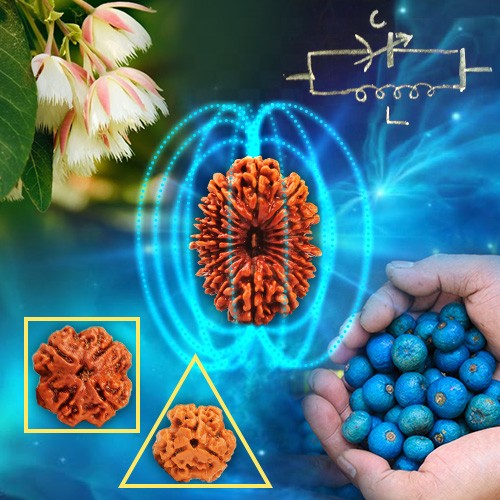

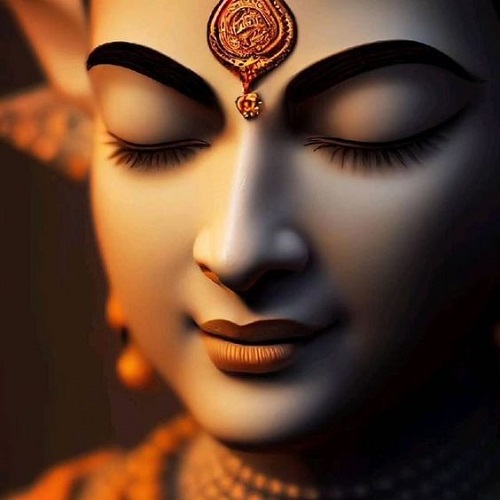
.jpg)
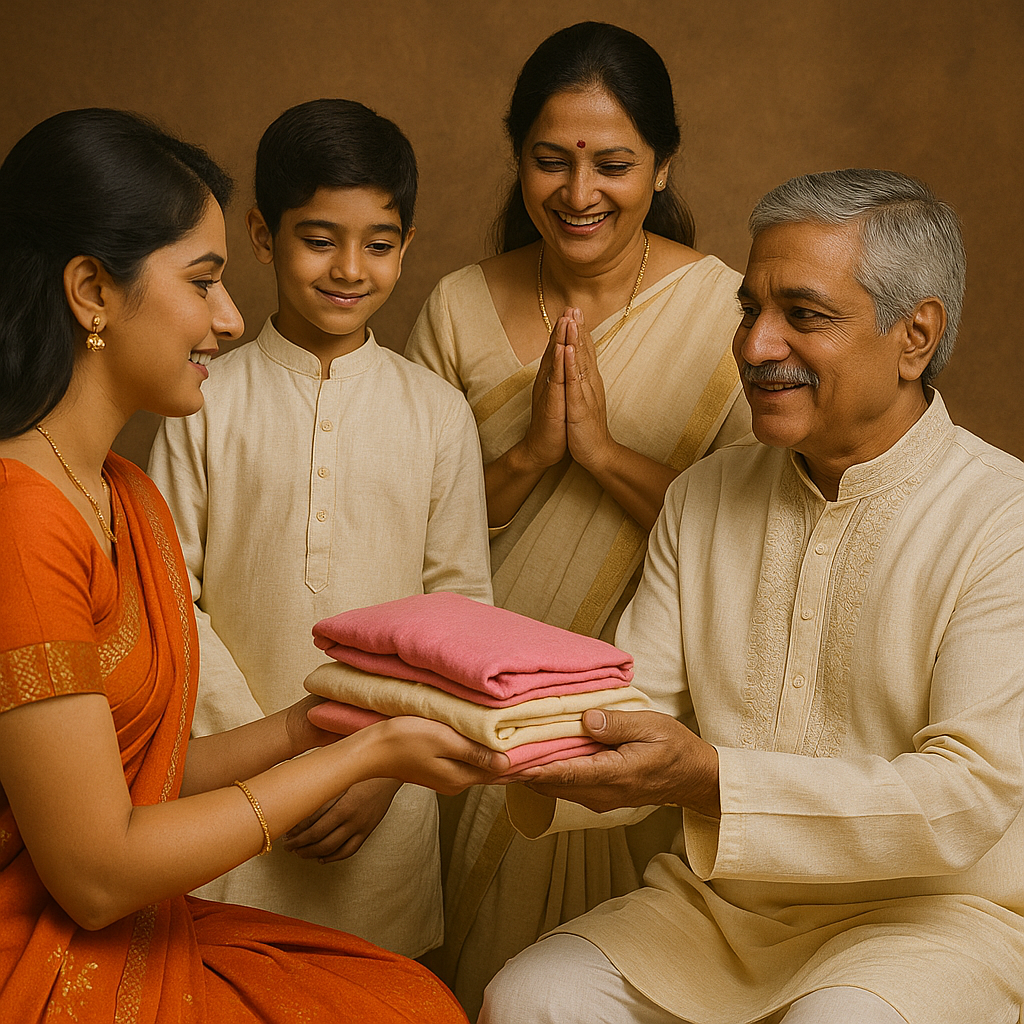

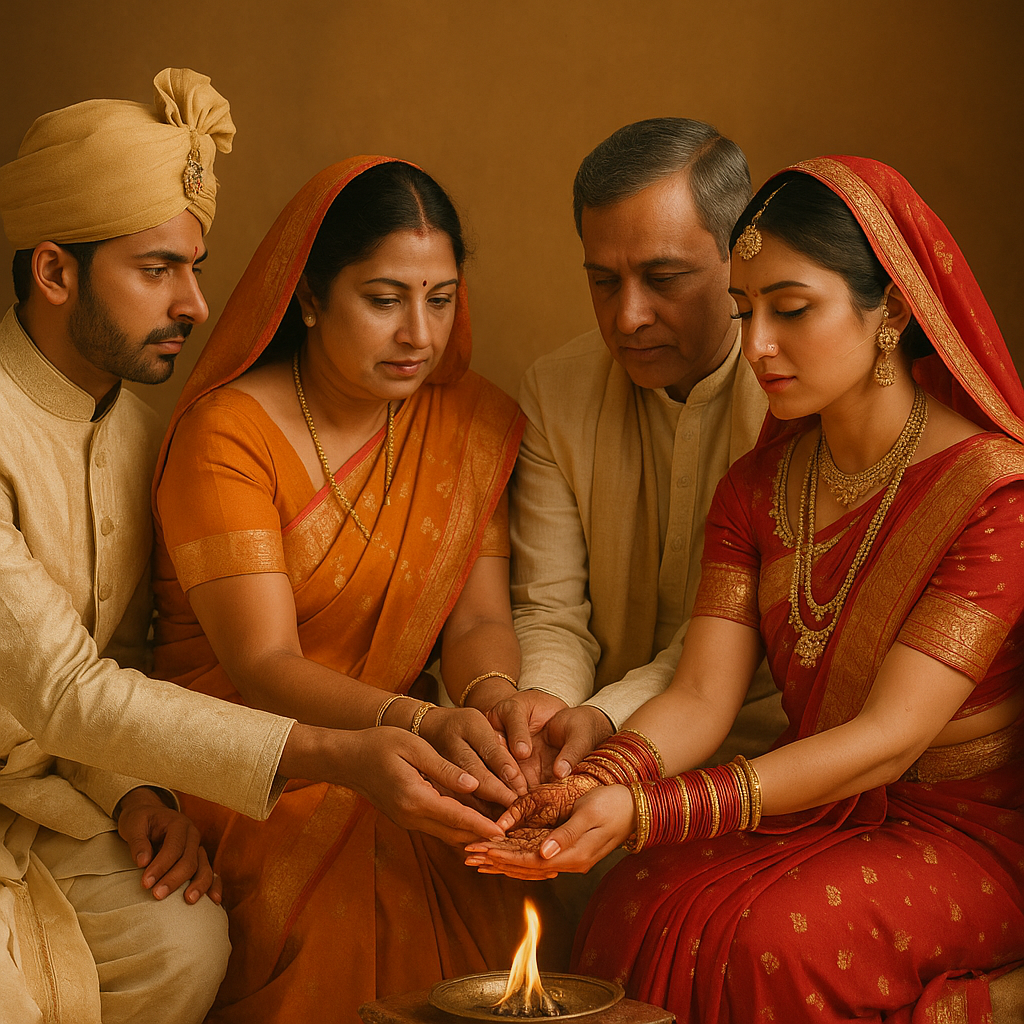
Comments 0
Leave your thought here